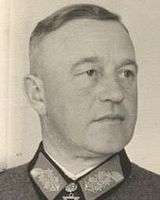Friedrich-Wilhelm Müller
| Friedrich-Wilhelm Müller | |
|---|---|
 Müller in 1944 | |
| Nickname(s) | The Butcher of Crete |
| Born |
29 August 1897 Barmen, Prussia |
| Died |
20 May 1947 (aged 49) Athens, Greece |
| Allegiance |
|
| Service/ |
|
| Years of service | 1915–45 |
| Rank | General of the Infantry |
| Battles/wars | |
| Awards | Knight's Cross of the Iron Cross with Oak Leaves and Swords |
Friedrich-Wilhelm Müller (29 August 1897 – 20 May 1947) was a general in the Wehrmacht of Nazi Germany during World War II. Müller was born in Barmen, Prussia. When the Great War began, Friedrich-Wilhelm Müller served as an infantryman with German 2nd Infantry Regiment. In 1915, he was promoted to 2nd Lieutenant of the 266th Regiment. After WWI, Müller remained in the German Army and continued to rise through the ranks, obtaining the rank of major in 1936. Shortly after WWII began, Müller was made a Lieutenant Colonel.
As the commanding officer of 105th Infantry Regiment, he saw action with the Soviets, for which he was awarded the Knight's Cross of the Iron Cross in 1941 and Oak Leaves to his Knight's Cross in 1942. In Aug 1942, Müller was made the commanding officer of 22nd Air Landing Infantry Division. Müller became notorious as a most brutal commander responsible for several atrocities against Greek civilians.
The attacks on civilians included the massacres at Viannos, Anogia, Amari, and Damasta. During the autumn of 1943, Müller led the German forces in their victory over the Italian-British forces in the Dodecanese Campaign. On the 6 October 1943, on the island of Kos, under his orders, German forces killed and buried in mass graves over one hundred Italian army officers captured at the end of the battle for the island, who would not side with their former allies.[1] On 1 July 1944, he replaced Bruno Brauer as commander of occupied Crete. His infamy earned him the nickname of "The Butcher of Crete."
Müller was also responsible for the Holocaust of Kedros on 22 August 1944. Under his orders, the Wehrmacht infantry killed 164 Greek civilians which was followed in the coming days by the razing of most villages, looting, and the destruction of livestock and harvests.[2] By 1945, Müller commanded the German 4th Army on the Eastern Front. Müller ended the war in East Prussia where he surrendered to the Red Army.
After the war, he was tried by a Greek military court for war crimes. In 1946, Müller was convicted by a Greek court in Athens for the massacres of hostages for reprisals. He was sentenced to death on 9 December 1946 and executed by firing squad on 20 May 1947,[3] along with former General Bruno Bräuer, on the anniversary of the German invasion of Crete.
Awards
- Iron Cross (1914) 1st Class (25 May 1916) & 2nd Class (29 August 1916)[4]
- Clasp to the Iron Cross (1939) 1st Class (22 December 1939) & 2nd Class (12 June 1940)[4]
- German Cross in Gold on 18 June 1943 as Generalleutnant and commander of the 22. Infanterie-Division[5]
- Knight's Cross of the Iron Cross with Oak Leaves and Swords
See also
References
Citations
- ↑ Isabella Insolvibile, Kos 1943-1948. La strage, la storia, Edizioni Scientifiche Italiane (31 December 2012)
- ↑ Keefe, Thomas. (2016). This Day in Genocide. San Bernardino, CA: Kincora Press., p. 262.
- ↑ "Archived copy". Archived from the original on 1 April 2012. Retrieved 21 May 2016.
- 1 2 Thomas 1998, p. 104.
- ↑ Patzwall & Scherzer 2001, p. 318.
- 1 2 3 Scherzer 2007, p. 555.
Bibliography
- Beevor, Antony (1991). Crete: The Battle and the Resistance.
- Patzwall, Klaus D.; Scherzer, Veit (2001). Das Deutsche Kreuz 1941 – 1945 Geschichte und Inhaber Band II [The German Cross 1941 – 1945 History and Recipients Volume 2] (in German). Norderstedt, Germany: Verlag Klaus D. Patzwall. ISBN 978-3-931533-45-8.
- Scherzer, Veit (2007). Die Ritterkreuzträger 1939–1945 Die Inhaber des Ritterkreuzes des Eisernen Kreuzes 1939 von Heer, Luftwaffe, Kriegsmarine, Waffen-SS, Volkssturm sowie mit Deutschland verbündeter Streitkräfte nach den Unterlagen des Bundesarchives [The Knight's Cross Bearers 1939–1945 The Holders of the Knight's Cross of the Iron Cross 1939 by Army, Air Force, Navy, Waffen-SS, Volkssturm and Allied Forces with Germany According to the Documents of the Federal Archives] (in German). Jena, Germany: Scherzers Militaer-Verlag. ISBN 978-3-938845-17-2.
- Thomas, Franz (1998). Die Eichenlaubträger 1939–1945 Band 2: L–Z [The Oak Leaves Bearers 1939–1945 Volume 2: L–Z] (in German). Osnabrück, Germany: Biblio-Verlag. ISBN 978-3-7648-2300-9.
| Military offices | ||
|---|---|---|
| Preceded by General der Infanterie Ludwig Wolff |
Commander of 22. Infanterie-Division 1 August 1942 – 15 February 1944 |
Succeeded by Generalmajor Heinrich Kreipe |
| Preceded by Generalleutnant Hermann Böhme |
Commander of V. Armeekorps 4 May 1944 – 2 June 1944 |
Succeeded by General der Infanterie Dr. Franz Beyer |
| Preceded by General der Infantrie Friedrich Hoßbach |
Commander of 4. Armee 29 January 1945 – 27 April 1945 |
Succeeded by none |